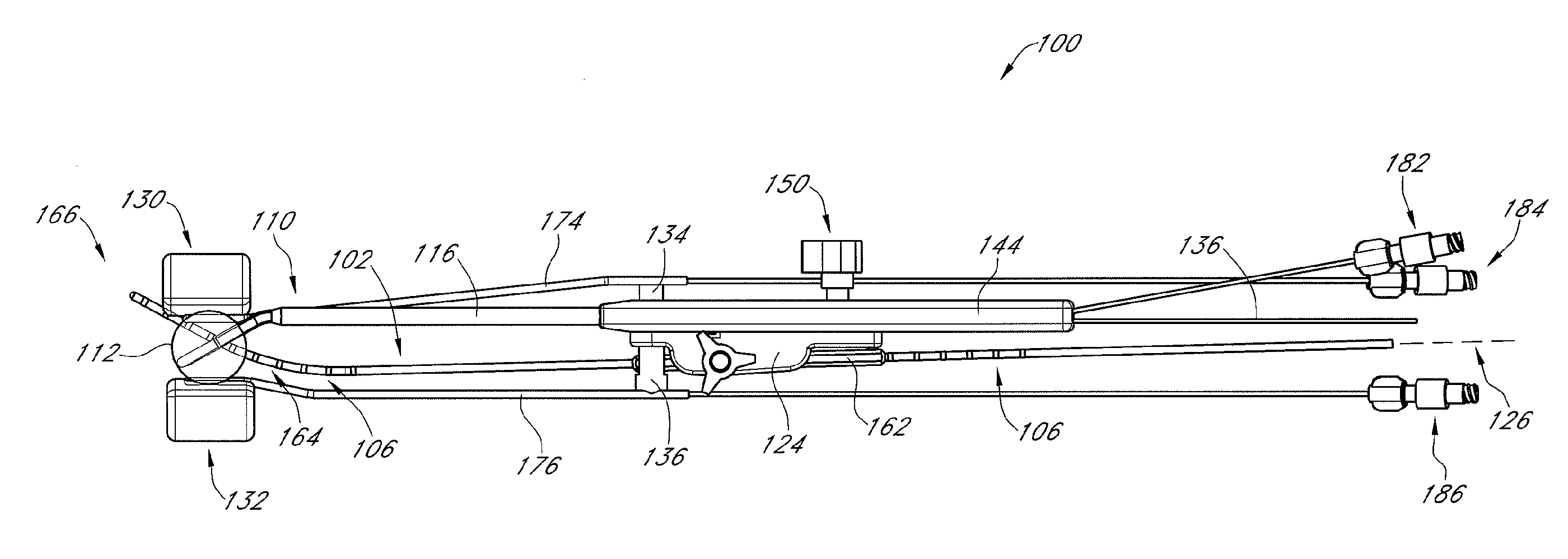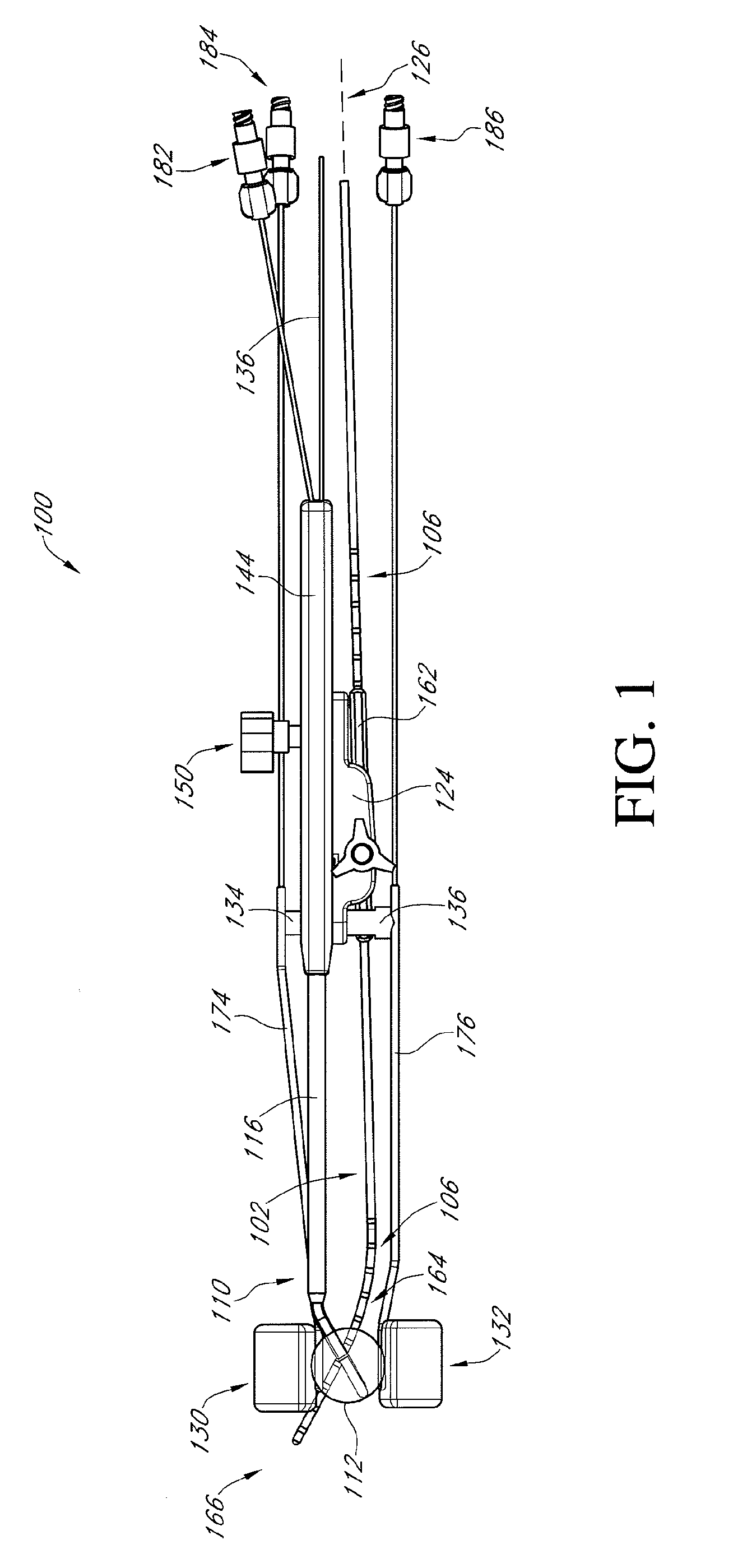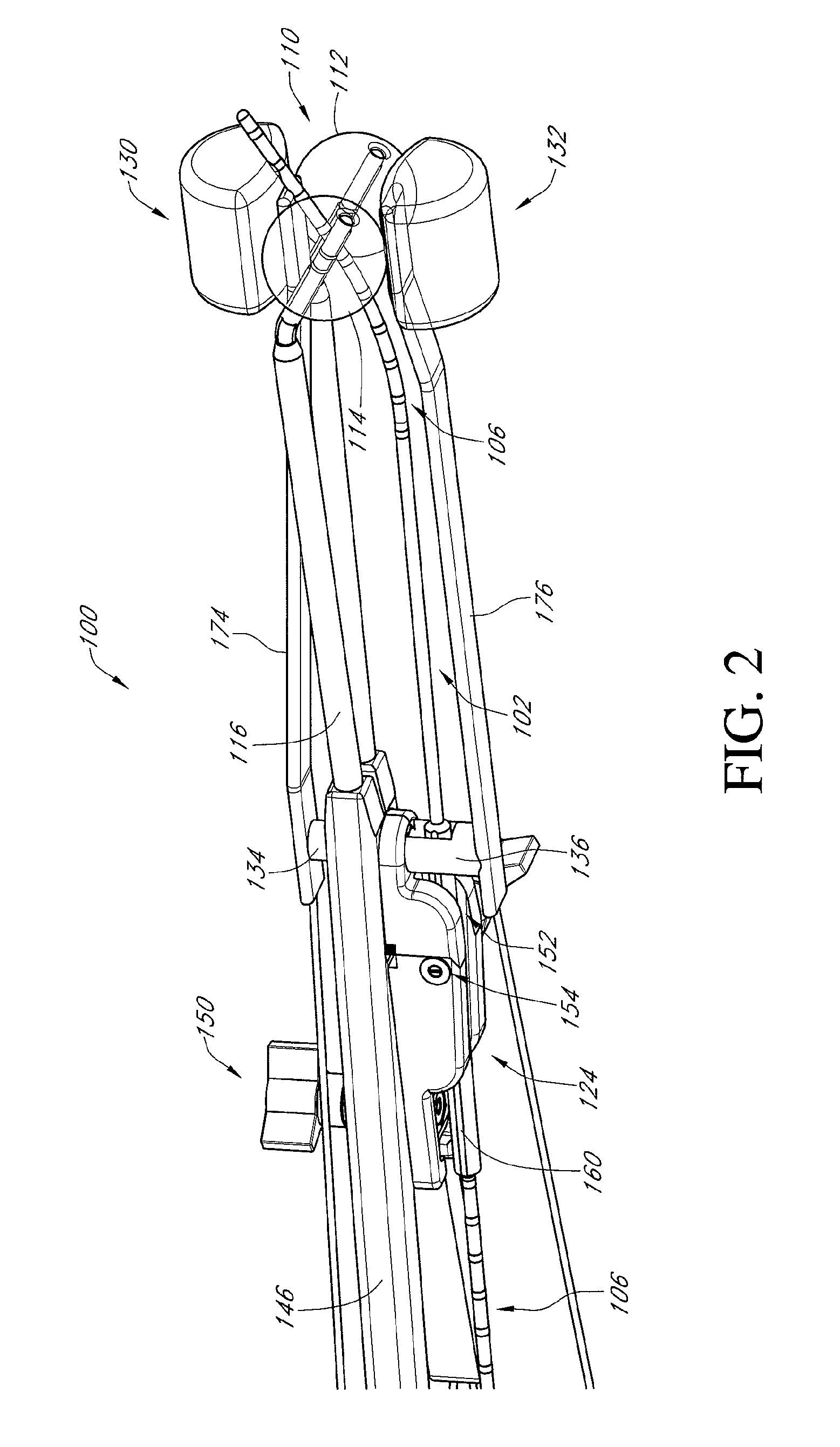[0009]The present application relates to devices and methods for treating cervical and / or uterine cancers in brachytherapy with an intracavitary brachytherapy applicator to harness the benefits of brachytherapy in addition to easing and improving the implant procedure. Some embodiments comprise an advanced applicator
system built for high and / or
low dose rate (HDR and LDR) brachytherapy using a novel and innovative design with the aim of easier implantation of the applicator.
[0010]According to some embodiments, an intracavitary brachytherapy applicator has a tandem and first and second inflatable ovoids. The tandem and ovoids are adapted to deliver an implant
radiation dose for treatment of a patient. In some embodiments the applicator comprises one or more retractors. The ovoids are preferably coupled to an ovoid
assembly to support the ovoids and to control the relative position of the ovoids. The tandem is preferably releasably coupled to the ovoid assembly and is adjustable relative to the ovoid assembly. The tandem preferably pivots and translates relative to the ovoid assembly. The tandem is preferably coupled to the ovoid assembly in a manner that limits or restricts rotation of the tandem about a longitudinal axis of the tandem. In some embodiments retractors are releasably coupled with the ovoid assembly. A first retractor can be positioned to retract the bladder of a patient during treatment and a second retractor can be positioned to retract the rectum of a patient during treatment. The retractors are preferably inflatable to at least partially retract the bladder and rectum from a treatment site. In some embodiments the tandem is preferably integrated with an
endoscope to facilitate treatment. Embodiments of the present application provide advantages over the Fletcher-Suit-Delclos (FSD) afterloading intracavitary brachytherapy applicators.
[0011]According to one embodiment, an applicator comprises a tandem
catheter and comprises two colpostats arranged for introduction of radioactive sources for intracavitary brachytherapy. The tandem can be integrated with an
endoscope in some embodiments that gives the capability of locating the
cervical os and guiding the tandem into the uterine canal. The conventional FSD applicator colpostats are made of variously sized rigid caps. According to one embodiment, the applicator comprises two inflatable ovoid balloons with the capability of expansion to multiple sizes through iodinated
saline. To replace inadequate retraction offered by currently used vaginal packing, two additional semi-cylindrical balloons are preferably attached to the ovoid assembly for retracting the bladder and rectum to lower the
radiation dose received by these organs. The applicator preferably provides a geometrically optimum implant where the tandem is positioned to bisect the ovoids, the ovoids are inflated and positioned to the largest size appropriate to fit the
anatomy of the patient, and the bladder and the rectum are pushed away from a plane of the implant by one or more retractors. In some embodiments the retractors push the bladder and rectum away from a plane of the implant by at least two centimeters. The applicator implements inflatable retractors for isolating the patient's bladder and the rectum from radioactive sources, lowering the radiation dosage absorbed by these critical structures. An
endoscope integrated with the tandem, in some embodiments, can provide advantages such as, for example, locating the
cervical os more easily, limiting uterine perforations, sounding the
uterus, and guiding the tandem through the uterine canal.
[0012]According to one method, an embodiment of the applicator is provided having a tandem and a dual ovoid assembly. The tandem may have a fiberoptic endoscope integrated with it, so the
cervical os can easily be found instead of the patient being blindly poked with a speculum placed in the
vaginal canal. The tandem and the collapsed
balloon dual ovoid assembly can easily be inserted as a single unit into the
vaginal canal. The tandem may be guided by endoscope into the cervical os and uterine canal, where the ovoids may be placed in the cervical fornices. The ovoids can comprise two balloons that are inflated with desired volumes of iodinated
saline. The ovoids can conform to the cervical tumor and can provide adaptive brachytherapy. The applicator can allow for the tandem and ovoids to be assembled and / or configured rapidly. Adjustments to the
system can be completed outside of the patient, similar to a laproscopy procedure. Advantages of the applicator systems and methods of use include simplification of the use of the implant, utilizing fewer parts, adjustable ovoids fitting the patient fornices with comfort, and the inflatable retraction mechanism to separate and give adequate distance to the bladder and rectum. This will optimize the
dose to the
cervix and
uterus, minimizing the dose to these critical structures.
[0013]In some embodiments, advantages of applicator systems and methods may include easier and faster implantation. The applicator can cause less or no pain to the patient. The applicator can reduce complications to the patient. The applicator can have simple and integrated applicator parts. Methods of using the applicator and performing treatments can be reproducible. The applicator can provide improved implant geometry. The applicator can be configured to provide for manipulations to be done outside the vaginal and uterine canals, thus making the implant
less invasive and geometrically advantageous. The applicator can provide improved radiation
dosimetry and lower dose to bladder and rectum.
 Login to View More
Login to View More  Login to View More
Login to View More 


